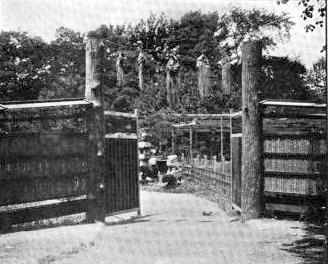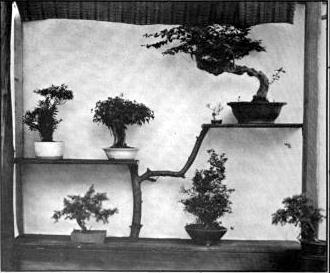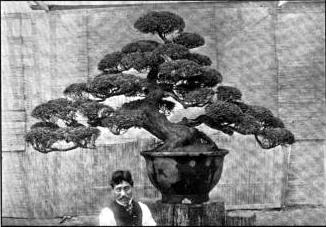"A Bit of Japan in America" by Vincent Van Marter Beede
(1900):
ENTRANCE TO THE TEA-GARDEN Copyright by Arthur Hewitt, East Orange, N.J. "A TABLET legend in a tea-garden at Omori, Japan, declares that 'the sight of the
plum-blossom causes the ink to flow in the writing-room,' and one is inclined to endorse the words when the delicate,
blended sweetness of unnamable flowers greets him before he has put foot across the entrance of a Japanese tea-garden
situate [sic] half an hour's railway journey from New York, and all but on the side of Orange
Mountain, New Jersey... [570]...

DECORATIVE ARRANGEMENT OF JAPANESE PLANTS AND DWARF TREES Copyright by Arthur Hewitt, East Orange, N.J. [571] 
THE RAREST DWARFED TREE OUTSIDE OF JAPAN Copyright by Arthur Hewitt, East Orange, N.J. "Tiny trees as perfect in their dwarfhood as though they had attained full stature, grow sturdily -- rather, stopped growing -- in shallow porcelain dishes. A two-foot maple aged seventy-five years had leaved as greenly as the fifty-foot cousin on our lawn at home. These diminutive growths reminded us of Stevenson's verses concerning 'The Little Land.' One needs but to bring his eyes on a level with a miniature magnolia to find himself among the elves. Some of these trees are dwarfs among dwarfs. A hornbeam six inches high clung to a three-inch 'boulder,' and a juniper of the same size was the center of attraction in a tiny garden where a lakelet bathed the foot of a rocky bluff. A winding path, strewn with carefully-chosen stepping-stones, led to the water, in which a porcelain coolie was watching a porcelain horse in the act of drinking. An atmosphere genuinely eastern surrounded the three-foot landscape." 1 |